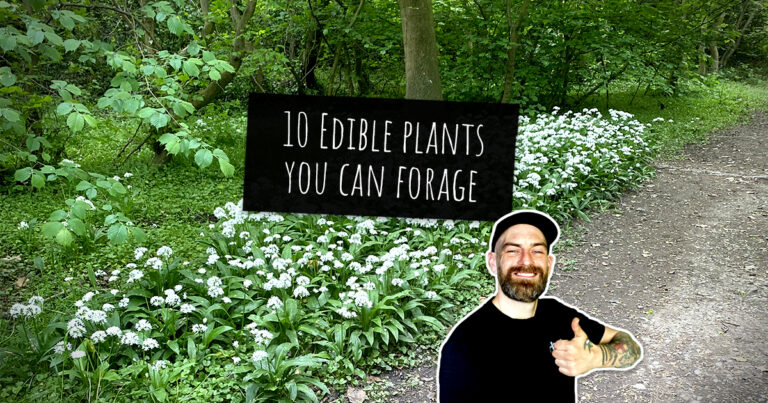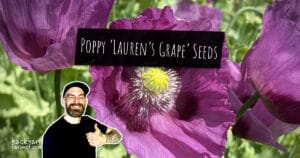Table of contents
- Intro: 10 Edible Plants You Can Forage in the UK
- 10 Wild Edible Plants You Can Forage in Your Backyard
- 1. Dandelion (Taraxacum)
- 2. Hairy bittercress (Cardamine hirsute)
- 3. Wild onion (Allium vineale)
- 4. Brambles (Rubus fruticosus)
- 5. Elderflower (Sambucus)
- 6. Hedge Garlic (Alliara petiolata)
- 7. Ground Elder (Aegopodium podagraria)
- 8. Wild garlic (Allium ursinum)
- 9. Goosegrass or cleavers (Galium aparine)
- 10. Nettles (Urtica dioica)
- Bonus Section: Edible Plants You Can Grow in the UK
- Conclusion: Embrace the Wild Side of Your Plate
Intro: 10 Edible Plants You Can Forage in the UK
Foraging is making a comeback—and it’s easy to see why. With more people turning to sustainable living and seeking ways to reconnect with the outdoors, edible plants in the UK offer an abundant, free, and often overlooked source of nutrition. Whether you’re wandering along hedgerows, exploring woodland trails, or even just checking your own garden, there’s a world of wild edible plants in the UK quietly growing all around you.
👉 New to this? Start with our Foraging for Beginners UK guide for essential tips and safety advice.
Why Forage in the UK?
- Reconnect with nature and the seasonal rhythms of your local area
- Save money by harvesting fresh, wild food
- Support biodiversity by choosing low-impact ingredients
- Discover bold, unique flavours beyond the supermarket

Who Is This Guide For?
This guide is for beginners and casual foragers across Britain looking to:
- Build confidence identifying edible wild plants in the UK
- Learn how to forage safely and responsibly in local green spaces
What You’ll Learn
We’ll walk you through ten easy-to-spot UK edible plants, including staples like nettles and dandelions, plus lesser-known gems like hairy bittercress and ground elder. Each plant is:
- Common across the UK
- Simple to identify
- Safe to forage with a few tips
- Packed with uses for food, tea, or remedies
A Quick Note on Foraging Etiquette
Foraging is legal in many areas, but it’s important to be mindful. We’ve included:
- UK foraging laws you should know
- ID tips to avoid mix-ups
- Harvesting advice for responsible, low-impact gathering
By the end of this guide, you’ll be ready to spot, pick, and enjoy some of the most useful and rewarding wild edible plants the UK has to offer—with a fresh perspective and maybe a basket in hand.
Let’s dive into ten beginner-friendly edible plants you can forage in the UK today.
10 Wild Edible Plants You Can Forage in Your Backyard
If you’ve got a typical suburban British garden, chances are you already have a few wild edible plants growing nearby—especially common leafy edibles that often go unnoticed. These so-called “weeds” are actually nutritious, flavour-packed plants that have been part of the forager’s toolkit for centuries.
Many of the most useful edible plants in the UK grow right at your doorstep. From dandelions to hairy bittercress, these everyday greens are full of vitamins and can easily be added to salads, teas, or cooked dishes. You might be surprised by just how many edible plants in your garden you’ve been walking past!
Top 10 Edible Plants to Forage in the UK
Here are ten of the most common wild edible plants found in British gardens, hedgerows, and green spaces. They’re a great starting point for beginners: easy to identify, safe to forage, and surprisingly tasty.
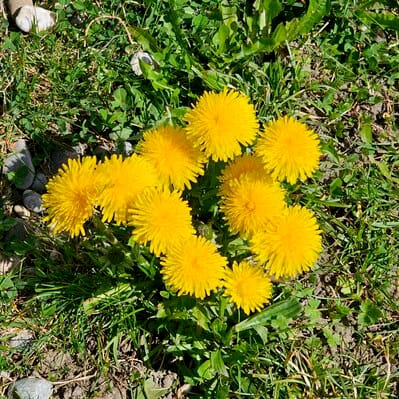
1. Dandelion (Taraxacum)
Often dismissed as a pesky weed, the dandelion is actually one of the most useful wild edible plants in the UK. Every part of the plant is edible—from its deep taproot to the bright yellow flowers.
The young leaves add a peppery kick to salads and can easily stand in for rocket. The flowers bring a subtle sweetness, great for teas or homemade syrups. Meanwhile, the roots can be roasted and ground into a bitter, caffeine-free coffee alternative—a traditional energy drink used for centuries.
Ways to use dandelion:
- 🌱 Young leaves: fresh in salads or sautéed
- 🌼 Flowers: infused in honey or steeped for tea
- 🌿 Roots: roasted for coffee or added to broth
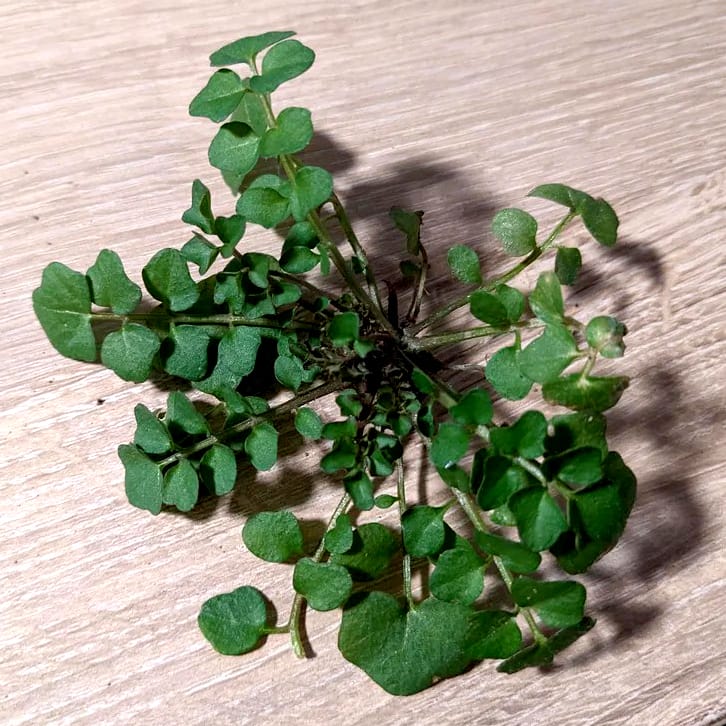
2. Hairy bittercress (Cardamine hirsute)
Hairy bittercress grows almost year-round in the UK and pops up in gardens, paths, and even pots. Its mild, peppery flavour is similar to cress—great fresh in salads or on sandwiches.
You can confuse it with other weeds, but none are toxic. The best way to be sure? Taste a leaf—it should have a clean, mustardy kick. Avoid uprooting it without permission. If you do get a clump, it grows well in pots on a windowsill with regular watering.
Ways to use hairy bittercress:
- 🥗 Sprinkle on salads for a mild kick
- 🥪 Add to sandwiches or wraps
- 🌿 Grow in pots for a continuous harvest
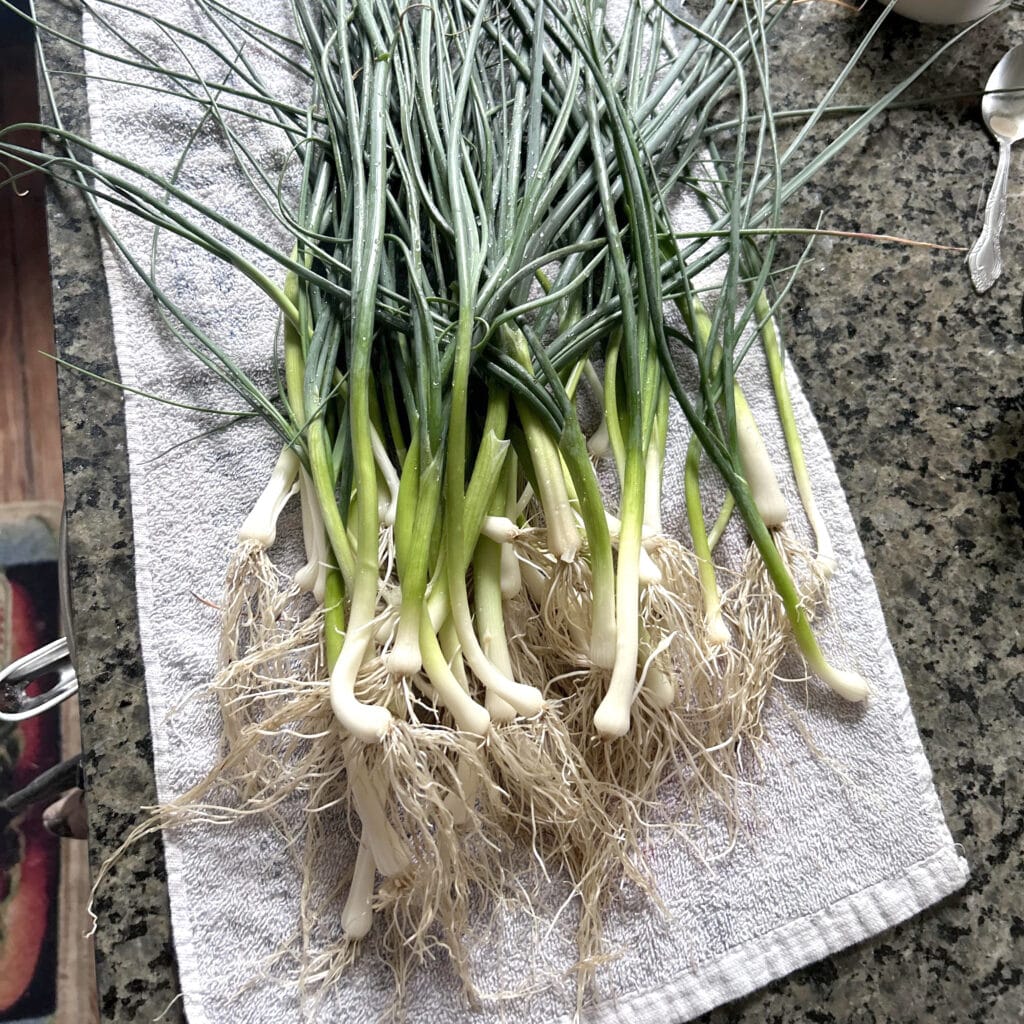
3. Wild onion (Allium vineale)
Wild onion—also known as crow garlic or onion grass—grows widely across the UK, especially in coastal areas, hedgerows, grassy banks, and fields. You’ll often find it in clumps along footpaths or scattered through cereal crops like wheat.
Its slender, hollow leaves carry a strong garlic-onion flavour and can be used much like chives. The small bulbs are edible too—great fresh or dried as a seasoning. Foraging is best in late winter to early spring, before the leaves toughen. With permission, you can gently dig up the bulbs for use in broths, pickles, or seasoning blends.
Ways to use wild onion:
- 🌿 Snip leaves into salads, soups, or egg dishes
- 🧄 Dry or pickle the bulbs as a seasoning
- 🌾 Grow in a container for easy access
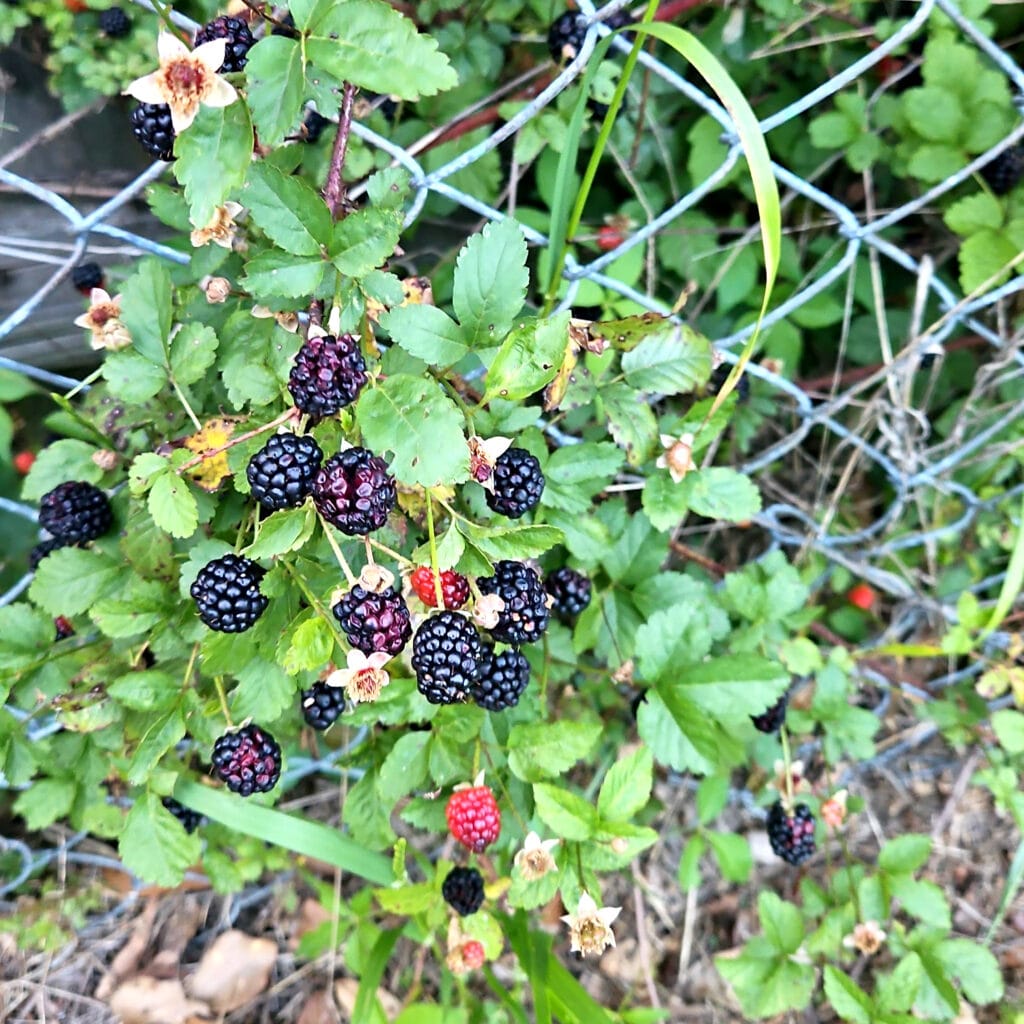
4. Brambles (Rubus fruticosus)
Brambles are one of the most recognisable wild plants in the UK, with their tangles of thorny stems and clusters of blackberries. Dozens of species exist, but all produce the familiar fruit—perfect for snacking, making jam, or adding to desserts.
The young leaves can also be used to make a simple herbal tea. In traditional herbalism, bramble leaves and bark were valued for their astringent properties and used to soothe digestive issues like diarrhoea or haemorrhoids.
Ways to use brambles:
- 🌿 Dry leaves or bark for traditional remedies
- 🍇 Eat the berries fresh or use in pies and jam
- 🍵 Steep the leaves for a fruity herbal tea
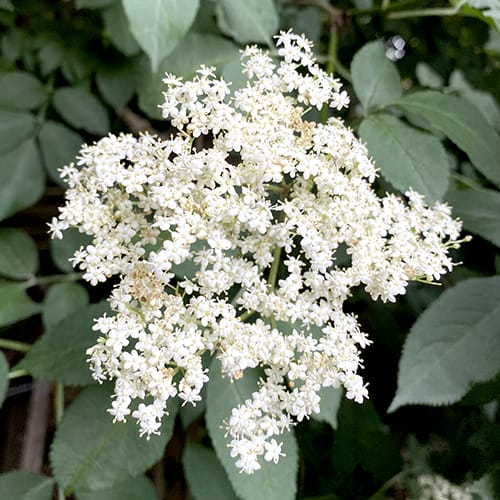
5. Elderflower (Sambucus)
Elderflowers bloom abundantly across the UK in late spring, filling hedgerows with their creamy white clusters. If you’ve never tried homemade elderflower cordial, now’s the time—it’s floral, refreshing, and easy to make.
Beyond its flavour, elderflower has a long history in folk medicine. It’s been used to relieve colds, sinus issues, and hay fever. When made into a cordial, it may even help reduce allergy symptoms thanks to its natural antihistamine effects.
Ways to use elderflower:
- 🌿 Dry the flowers for year-round herbal remedies
- 🍋 Make cordial or syrup for drinks and desserts
- 🌼 Infuse into teas for colds or hay fever relief
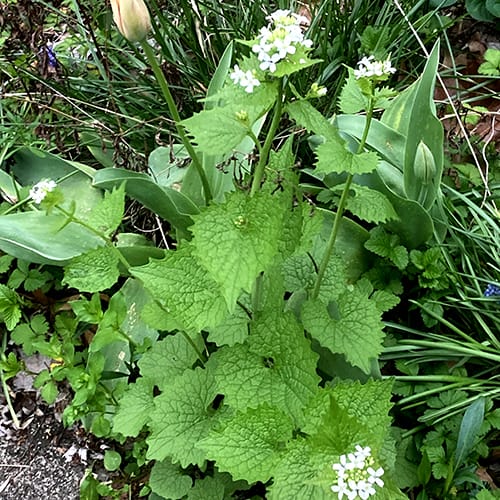
6. Hedge Garlic (Alliara petiolata)
Hedge garlic—also known as Jack-by-the-Hedge, Garlic Mustard, or Poor Man’s Mustard—is a versatile wild green with a flavour that sits somewhere between garlic and mustard. It’s a brilliant addition to salads, dressings, or even stirred into a warm grain dish.
This edible is available almost year-round thanks to its natural cold resistance, and it’s easy to identify with no dangerous lookalikes—making it a great choice for beginner foragers.
Ways to use hedge garlic:
- 🥗 Shred into leaf salads for a garlicky twist
- 🌿 Add to pesto or green sauces
- 🍞 Mix into savoury bread or herb butter
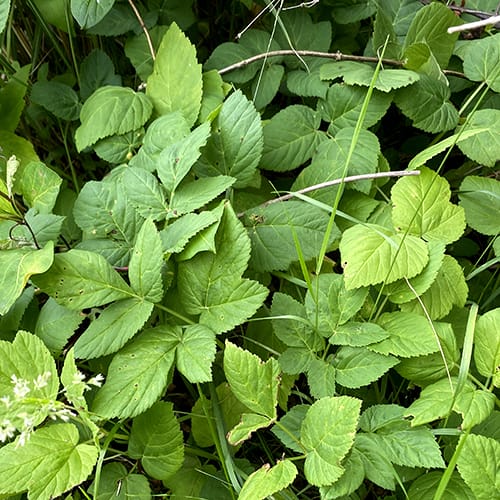
7. Ground Elder (Aegopodium podagraria)
Ground elder—also known as Goutweed, Herb Gerard, or Bishop’s Weed—was once brought to Britain by the Romans as a food crop. Though many gardeners now see it as a nuisance, foragers know it as a versatile edible with a flavour similar to parsley, but milder and sweeter.
Pick the young, tender leaves between March and October for salads, or cook them like spinach in soups and sautés. Avoid the tougher mature leaves, and take care not to confuse it with Dog’s Mercury, a toxic plant with hairy stems and single leaves (not clusters of three).
Ways to use ground elder:
- 🥗 Add young leaves to salads
- 🍲 Sauté or wilt like spinach
- 🌿 Use in herbal poultices for sore joints or inflammation
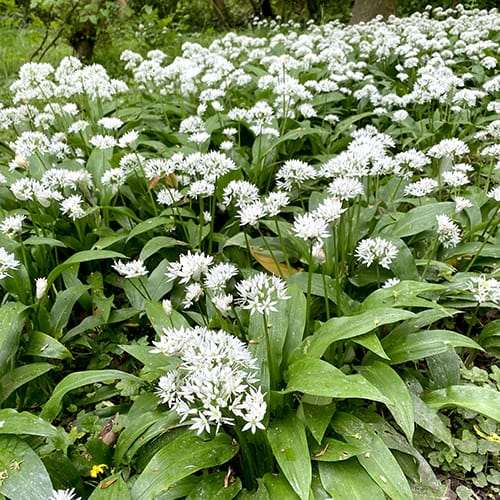
8. Wild garlic (Allium ursinum)
Wild garlic—also known as ramsons, bear garlic, or wood garlic—is a bold-flavoured favourite among UK foragers. Related to onions and leeks, it offers a punchy garlic kick that mellows with cooking. The leaves are great in pesto or soups, while the flower buds can be pickled or added raw for an extra burst of flavour.
You’ll find wild garlic from February to June, often carpeting woodland floors in shady, damp areas. It’s easy to spot by its broad leaves and strong garlic smell—a key feature to check, as a few lookalikes (like lily of the valley) can be toxic.
Ways to use wild garlic:
- 🌿 Blitz into pesto or oil
- 🧄 Use in place of garlic in cooked dishes
- 🌼 Pickle the buds for a garlicky garnish
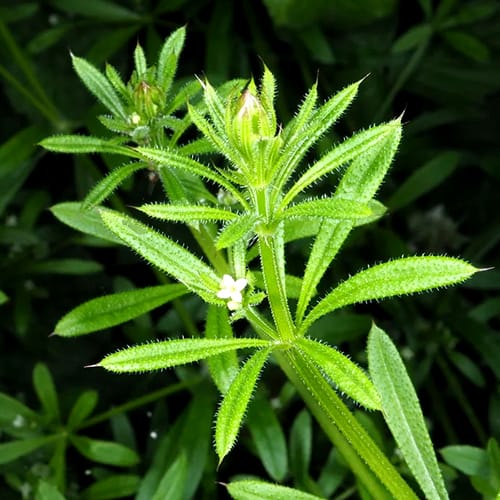
9. Goosegrass or cleavers (Galium aparine)
Often called ‘sticky weed’ for its knack for clinging to clothes, goosegrass is more than just a garden nuisance—it’s also edible. The young shoots are the best part to eat, either raw or cooked, with a fresh, grassy flavour. Once the plant matures, it becomes tough and bitter, so pick early.
Later in the season, the seeds can be harvested, roasted, and ground into a surprisingly decent coffee substitute. Goosegrass is a reliable choice for beginners—no toxic lookalikes and easy to identify.
Ways to use goosegrass:
- 🌱 Eat fresh young shoots raw or steamed
- ☕ Roast seeds to brew a wild coffee alternative
- 🧺 Use as a safe intro plant for new foragers
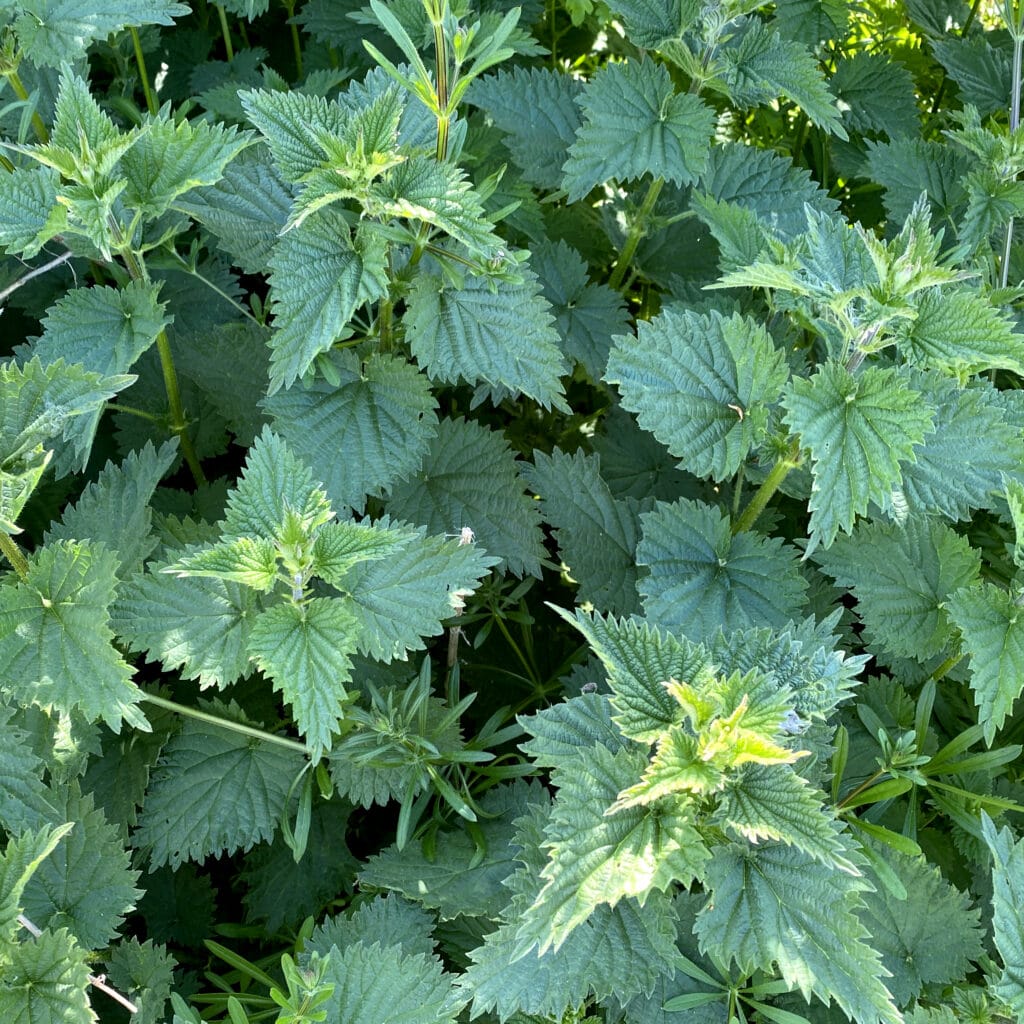
10. Nettles (Urtica dioica)
Often dismissed as a weed, nettles are one of the most useful wild plants in the UK. They grow abundantly in parks, hedgerows, and gardens, and while the sting puts many off, their edible and medicinal uses make them worth a second look.
Pick the young tips for cooking or making tea—the fresher the growth, the better the flavour. Cooked nettles are similar to spinach in texture with a mild, earthy taste. They also make a refreshing herbal tea and are packed with nutrients.
Ways to use nettles:
- 🍵 Brew tea from the young tops
- 🥬 Cook like spinach in soups or stews
- ♻️ Use stems for cordage or add leftovers to compost
Bonus Section: Edible Plants You Can Grow in the UK
While foraging is a brilliant way to get outside and reconnect with the land, there’s another hands-on path to self-reliance: growing your own edible plants in the UK. Plenty of the wild edible plants we forage for can thrive just as well in gardens, pots, or tucked into a sunny spot on your allotment.
By growing UK edible plants at home, you bring the forager’s spirit to your own backyard. You’ll enjoy the perks of fresh, seasonal produce—without needing to identify or track it in the wild. Plus, it’s a simple way to top up your foraged finds, build a low-maintenance edible garden, and support local biodiversity.
It’s easier than you might think to grow wild edible plants in the UK, even if you’re short on space or new to gardening.
Easy-to-Grow Wild Edible Plants (UK Garden-Friendly)
Here are a few wild edible UK plants that also make cracking garden companions:
- Wild Garlic (Allium ursinum): Shade-loving and aromatic—great under trees or along fences.
- Nettles (Urtica dioica): Packed with nutrients and loved by wildlife. Just mind the sting!
- Chickweed (Stellaria media): Quick-growing ground cover that’s mild, soft, and salad-ready.
- Dandelion (Taraxacum officinale): Let a few grow—leaves, flowers, and roots are all useful.
- Salad Burnet (Sanguisorba minor): A quirky little herb with a cucumber kick.
- Lovage (Levisticum officinale): Bold and leafy—ideal for flavouring soups and stews.
- Good King Henry (Blitum bonus-henricus): A hardy, old-school green that deserves a comeback.
Why Grow Edible Wild Plants?
- Support pollinators and native insects with every bloom
- Create low-maintenance edible spaces in your garden or plot
- Lower your food miles by growing closer to home
- Get to know plants intimately by observing them as they grow
You don’t need loads of room either. Even a few pots by the back door or a grow bag on the balcony can deliver wild food all year round.
👉 Want more ideas? Explore our guides on edible weeds, perennial herbs, and how to build a wildlife-friendly edible garden in the UK.
Conclusion: Embrace the Wild Side of Your Plate
Foraging isn’t just about gathering free food—it’s about reconnecting with nature, building knowledge, and rediscovering how to live more sustainably. By learning to spot and harvest edible plants in the UK, we rebuild that relationship with the land while picking up practical, time-tested skills.
Start Small, Grow Naturally
These ten wild edible plants in the UK are only the beginning. As you start noticing what’s growing in the hedgerows, woodlands, parks, or even your own garden, you’ll feel:
- More connected to your surroundings
- More confident identifying wild food
- More motivated to keep exploring
These first steps can set you on a lifelong path of recognising, appreciating, and responsibly using the edible wild plants the UK has to offer.
A Few Simple Rules for UK Foraging
- Understand local foraging laws before harvesting
- Harvest responsibly—take only what you’ll use
- Stick to common, non-protected species
- Avoid sensitive habitats and rare plants
- Leave no trace and respect the space
Keep Exploring Edible UK Plants
If this guide has inspired you to forage more often or grow your own edible UK plants, check out these next steps:
- 📘 Read our complete Foraging for Beginners UK guide
- 📬 Subscribe for seasonal wild plant profiles, edible weed guides, and growing tips
- Before foraging, it’s worth checking the UK government’s guide to protected and invasive wild plants to stay within the law.
Stay curious, forage wisely, and enjoy the edible treasures growing all around you.
